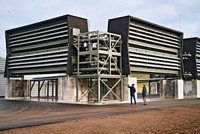Advertisement
Grab your lab coat. Let's get started
Welcome!
Welcome!
Create an account below to get 6 C&EN articles per month, receive newsletters and more - all free.
It seems this is your first time logging in online. Please enter the following information to continue.
As an ACS member you automatically get access to this site. All we need is few more details to create your reading experience.
Not you? Sign in with a different account.
Not you? Sign in with a different account.
ERROR 1
ERROR 1
ERROR 2
ERROR 2
ERROR 2
ERROR 2
ERROR 2
Password and Confirm password must match.
If you have an ACS member number, please enter it here so we can link this account to your membership. (optional)
ERROR 2
ACS values your privacy. By submitting your information, you are gaining access to C&EN and subscribing to our weekly newsletter. We use the information you provide to make your reading experience better, and we will never sell your data to third party members.
Investment
Cash rushes in for CO₂ removal
Credit purchases and investment dollars boost direct air capture and other CO₂-drawdown technology
by Craig Bettenhausen
April 20, 2022
| A version of this story appeared in
Volume 100, Issue 14

A recent report by the Intergovernmental Panel on Climate Change (IPCC), a United Nations program, says the world needs carbon dioxide removal at a large scale to reach net-zero greenhouse gas emissions. A new round of purchasing and investment dollars is flowing to companies trying to make that happen.
The IPCC report considers carbon dioxide removal anything that takes CO2 from the atmosphere, including new trees, biomass-burning power plants that capture and store their carbon, and chemical technologies like direct air capture (DAC). As many as 15 gigatons per year must be removed alongside aggressive emission reductions to keep global warming to 1.5 °C, the report says.
On April 5, a day after the IPCC report came out, the DAC company Climeworks announced it had raised $650 million in private financing. Climeworks, one of the most commercially advanced carbon removal companies, operates a plant in Iceland that captures and sequesters 4,000 metric tons of CO2 per year. The firm says it will use the funds to build a plant 10 times as big and double its staff to 400 people.
Investor Chris Sacca says the market for carbon removal credits like those that Climeworks offers is in the billions of dollars, and there is not nearly enough supply. To get in on the action, Sacca has launched a $350 million venture capital fund focused on early-stage carbon removal start-ups.
“There has never been a better time to start a carbon removal company,” he wrote on April 14 in his company’s blog. “So, come to us with your wildest ideas. They don’t have to be fully baked, and we have no preconceived notions about what might work.”
A purchasing fund launched this month is looking for new carbon removal firms. The digital payment company Stripe has recruited the tech companies Alphabet, Meta, and Shopify and the consulting firm McKinsey & Co. to purchase a combined $950 million in carbon removal credits by 2030 through its subsidiary Frontier Climate.
Carbon removal firms will be eligible to win some of that business if their methods store carbon for more than 1,000 years and have a clear path to remove at least 0.5 gigatons per year at $100 per metric ton or less, a rubric that favors technological approaches over nature-based ones. Stripe is also an investor in Sacca’s fund.
In a video about the program, Frontier says the tech company commitment is 30 times as much as has been spent to date on carbon removal credits.
“Build and we will buy,” the video concludes. At the same time, Frontier says, $950 million is less than 1% of the annual spending on carbon removal that will be needed, alongside investment in emission reduction, to mitigate climate change.



Join the conversation
Contact the reporter
Submit a Letter to the Editor for publication
Engage with us on Twitter